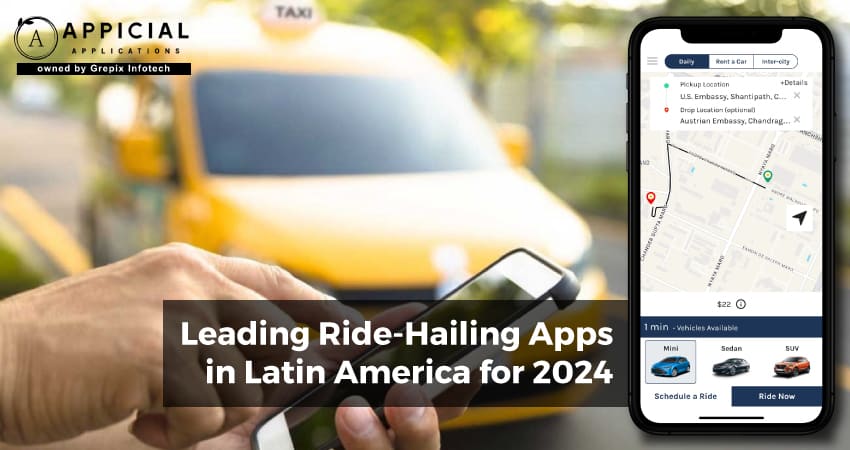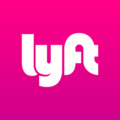
Leading Ride-Hailing Apps in Latin America for 2024
The ride-hailing sector has witnessed notable expansion and increased rivalry in the past few years. While Uber and Lyft initially held sway, a multitude of fresh entrants, both on a global and local scale, have joined the fray. This proliferation has notably heightened the level of competition within the industry.
In the Latin American context, this transformation has been notably prominent. Despite the market undergoing consolidation, resulting in fewer major players, the remaining firms are actively engaged in expanding their geographic reach. This strategy isn't solely aimed at gaining a larger market share; rather, it represents a competition to establish the ultimate global leader in the ride-hailing industry.
Goldman Sachs anticipates significant expansion in the ride-hailing sector, projecting its worth to approach approximately $285 billion by 2030. Playing a pivotal role in this surge is China's Didi Chuxing, which not only posed a formidable challenge to Uber's supremacy but also exceeded it, emerging as the globe's most valuable startup. Didi's relentless expansion tactics and inventive methodologies indicate a relentless momentum with no indications of deceleration.
Explore the diverse and dynamic ride-hailing landscape in Latin America with our comprehensive guide. This blog post introduces you to the leading ride-hailing apps across various countries in the region, highlighting their unique features and contributions to the transportation sector. Whether you're a local resident or an entrepreneur interested in Latin American markets, this guide provides valuable insights into the prominent ride-hailing services shaping the region's mobility landscape.
Didi has recently shifted its attention to Latin America, a region that holds substantial untapped opportunities within the ride-hailing sector. With expansive urban areas and a growing population increasingly embracing digital transport solutions, Latin America offers abundant prospects for ride-hailing services. Didi's entry into this market aligns with its goal to venture into new territories and strengthen its status as a prominent global player in the ride-hailing industry.
In general, the transformative shifts in the ride-hailing sector, particularly with the emergence of enterprises like Didi Chuxing venturing into fresh territories like Latin America, underscore the swift evolution of the industry and the extensive potential that persists for further development and expansion.
The Growing Influence of Ride-Hailing Apps
The embrace of ride-hailing applications is experiencing an upward trend, with user engagement estimated to climb to 21.9% by 2023 and further rising to 24.2% by 2027. Despite Uber's global dominance, spanning operations in more than 65 countries, urbanization and digitization in Latin America have paved the way for a varied array of local and international contenders in this industry.
Rapid Urbanization and Digital Solutions
Latin America, with a population exceeding 649 million, is undergoing swift urbanization. Projections indicate this growth will surge to 711 million within the next ten years, escalating the need for effective transport solutions such as ride-hailing and bike-sharing services.
Safety and Women-Focused Services
Concerns about safety in public transportation have contributed to the increased preference for ride-hailing services, which provide features such as GPS tracking and transparent pricing. Significantly, certain services are tailored specifically for women, especially in prominent urban centers like São Paulo.
Leading Ride-Sharing Taxi Apps in Latin America

1. Lyft
Lyft stands out as a widely-used ride-hailing application, extending its services throughout the United States and selected cities in Canada. Positioned as a direct competitor to Uber, Lyft enables users to secure rides via a mobile app, connecting them with available drivers in proximity. Recognized for its intuitive interface and a diverse array of choices, including standard, shared, and luxury rides, Lyft places a strong emphasis on community and interaction between drivers and passengers. This positions Lyft as a more amicable and socially conscious alternative within the ride-sharing market.

2. Uber
A prominent global player in the ride-hailing industry, Uber established its footprint in Latin America in 2013, marking a significant expansion in the region. Its success is notably pronounced in Mexico, solidifying its status as one of Uber's largest markets outside of the United States.
Having commenced operations in Latin America in 2013, Uber has emerged as a formidable force in the region. With a user base exceeding 36 million and offering employment opportunities to over a million drivers, the company has left an indelible mark. Mexico, in particular, stands as Uber's second-largest market globally, trailing only the U.S. Historically, Uber held a near-monopoly in the Mexican ride-sharing sector, facing minimal competition. Beyond Mexico, Uber's influence extends across more than 16 countries in Latin America, highlighting its substantial presence in the region.

3. Cabify
Hailing from Spain and headquartered in Madrid, Cabify strategically positions itself as a pivotal player in the Latin American ride-hailing sector. Bolstered by significant investments from its parent company, Maxi Mobility, Cabify has witnessed substantial growth in this geographical expanse.
The company boasts impressive user figures, asserting a user base surpassing 13 million. Notably, this user community has exhibited remarkable expansion, tripling from 2016 to 2017. Additionally, Cabify's completed trip count in 2017 soared sixfold compared to the preceding year, signaling a robust upward trajectory in its operational endeavors.
In the competitive realm of ride-hailing services, particularly in Brazil, Cabify emerges as a formidable contender against major players like 99, Uber, and Easy Taxi. A standout achievement is its attainment of approximately 40% market share in São Paulo, the largest city in Latin America. This substantial market share serves as a testament to Cabify's successful penetration and growth in this pivotal regional market.

4. 99 (formerly 99Taxis)
In the thriving urban landscape of Brazil, boasting a sizable population of approximately 180 million, the ride-hailing and taxi markets have become highly sought-after arenas. In this competitive milieu, 99 (formerly recognized as "99Taxis") carved out a substantial presence. Setting itself apart, the company offered services that transcended the conventional ride-hailing model. This encompassed exclusive offerings like 99 TOP and 99 POP, coupled with enhanced tools tailored for its driver network.
99's innovative strategies and comprehensive service portfolio facilitated rapid operational expansion. By the time it garnered attention from global investors, 99 had already cultivated a network of over 200,000 drivers and garnered 14 million users. This remarkable growth and potential attracted significant investment from Didi Chuxing, a prominent player in the global ride-hailing landscape hailing from China.
Also Read: How to Start Your Taxi Business with Indriver Clone

5. Easy Taxi
Commencing its journey in Latin America in 2011, Easy Taxi, initially backed by Rocket Internet, entered the scene two years after Uber's inauguration in San Francisco. In 2017, Maxi Mobility, under Cabify's ownership, acquired Easy Taxi, transforming it into a reliable taxi booking and tracking service provider. Maxi Mobility extends its operations across various Latin American countries, including Argentina, Mexico, Bolivia, Panama, Brazil, Peru, and Chile. To fortify its market presence amidst escalating competition from rivals like Uber, Easy Taxi orchestrated a merger with Tappsi, a Colombian taxi booking app, in 2015. This strategic consolidation of resources aimed to navigate the intensified competitive landscape. Having secured over $75 million in funding, Easy Taxi emerges as a potential target for investment or acquisition in the fiercely competitive Latin American ride-hailing sector, drawing attention from major players like Uber, Didi, and Softbank.
6. Beat (formerly TaxiBeat)
Beat, originally established as TaxiBeat, is a ride-hailing platform originating from Athens, Greece. Founded by Nikos Drandakis in collaboration with Kostis Sakkas, Michael Sfictos, and Nikos Damilakis in 2011, the company initiated its services, focusing on taxi and vehicle hire solutions. Despite its Greek origins, Beat has undergone substantial expansion, particularly in Latin America, where it operates in countries like Colombia, Mexico, Chile, Argentina, and Peru. The majority, exceeding 90%, of its ride-hailing operations are conducted beyond Greece, with a significant presence in these Latin American markets. Beat has gained recognition for its effective services, providing users in these regions with notable convenience.
7. Nekso
Nekso, a ride-hailing application originating from Toronto, Canada, distinguishes itself through a unique approach within the ride-hailing sector. Rather than the conventional model, Nekso facilitates the connection between passengers and licensed taxi companies, along with their drivers. A standout feature of Nekso is its provision for riders to hail a cab directly from the street, eliminating the necessity for an in-app request, a departure from the norm in typical ride-hailing services.
Initially concentrating its operations in Venezuela, Nekso has progressively expanded its footprint to encompass additional regions, including Panama, the Dominican Republic, Ecuador, and more. The company's innovative business model and its expansion into diverse markets underscore its flexibility and dedication to delivering diverse ride-hailing solutions to cater to the varied needs of customers in different geographical regions.
8. GrabTaxi
Originally known as GrabTaxi, Grab is a tech company based in Singapore renowned for its app that delivers a broad spectrum of services, including ride-hailing and logistics. Founded in 2012, it has expanded its operations across Southeast Asia, serving countries like Malaysia, Singapore, Indonesia, the Philippines, Vietnam, Thailand, Myanmar, and Cambodia.
Grab extends its offerings beyond the conventional scope of ride-hailing to encompass food delivery and digital financial services, positioning itself as a versatile platform. The company's strategic adaptation to cater to the unique requirements of each regional market has been instrumental in its success across Southeast Asia. Grab has emerged as one of the most prominent tech startups in the area, recognized for its easy-to-use app and a wide array of services.
9. Curb
Curb has emerged as a notable force in the U.S. ride-hailing sector, revolutionizing the traditional taxi service with its app-based booking system. Its strategy to focus on the requirements of conventional taxi drivers and adapt its technology for robust competition against larger rivals like Uber and Lyft has been pivotal in its progress.
In the last year, Curb has seen a remarkable 300% increase in its user base, now boasting over 100,000 drivers on its platform. This growth is credited to Curb's technology, which effectively meets the needs of both drivers and customers with features such as upfront pricing. This not only ensures fare transparency for riders but also benefits drivers by setting clear expectations for each trip.
The company's inception by Amos Tamam, who has extensive experience in the taxi industry, has been instrumental in aligning Curb's offerings with the specific needs of the taxi sector. By focusing on improving the lives of taxi drivers and offering affordable rides to passengers, Curb has carved out a distinctive niche in a market predominantly dominated by larger companies.
10. ZipCar
Founded in 2000, Zipcar is a prominent American car-sharing company that functions under the Avis Budget Group. It offers its members the flexibility to book vehicles for various durations, ranging from minutes to days, with the option of paying either monthly or annually in addition to the costs of reservations. Zipcar's comprehensive service package includes fuel, regular maintenance, a range of insurance options, and a designated parking space for each vehicle. As of September 2016, Zipcar boasted a membership of 1 million across 9 countries and 500 cities, providing access to about 10,000 vehicles. The company enables immediate membership registration and vehicle reservation through its mobile app, available on both Android and iPhone platforms, as well as through its website.
Conclusion
We delved into and analyzed the ride-hailing and taxi sectors specific to Latin America. Our research revealed significant potential in this region for taxi enterprises. The market trends and data from the ride-hailing segment in these areas highlight the substantial and profitable opportunities available for taxi businesses. Additionally, we explored the major competitors currently striving to dominate and lead in this competitive regional market.







